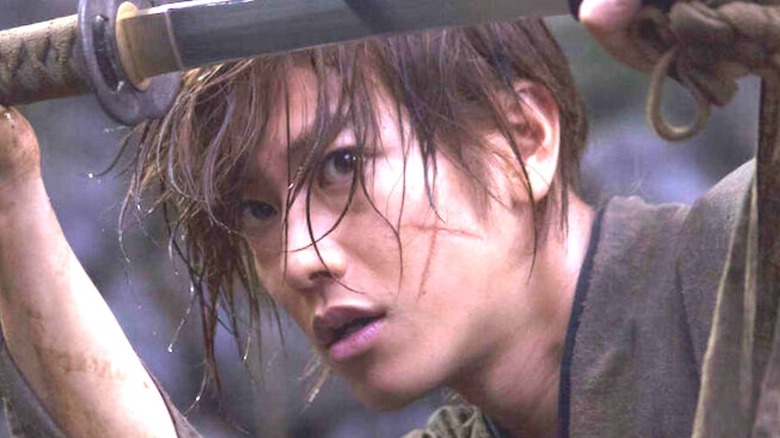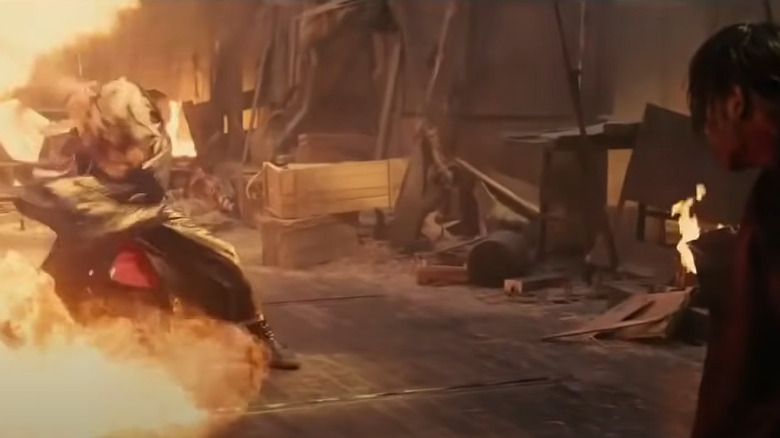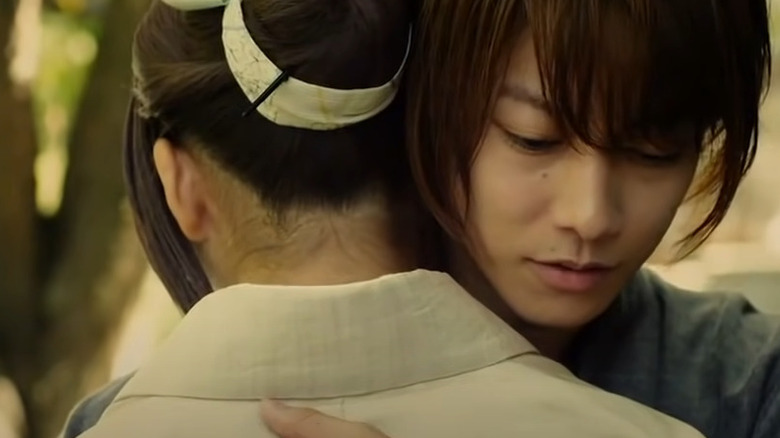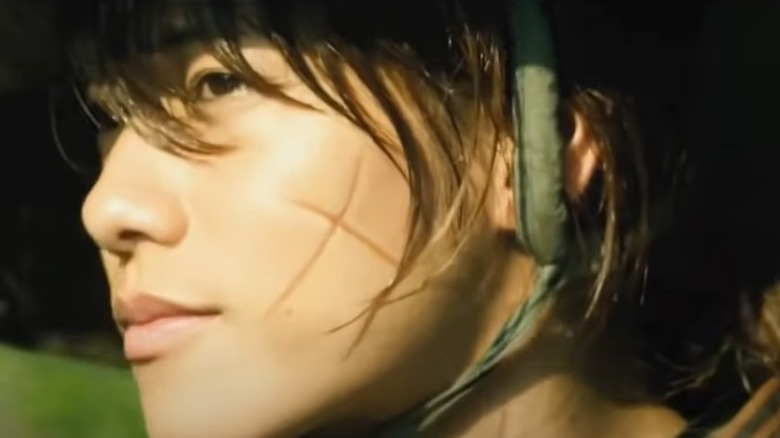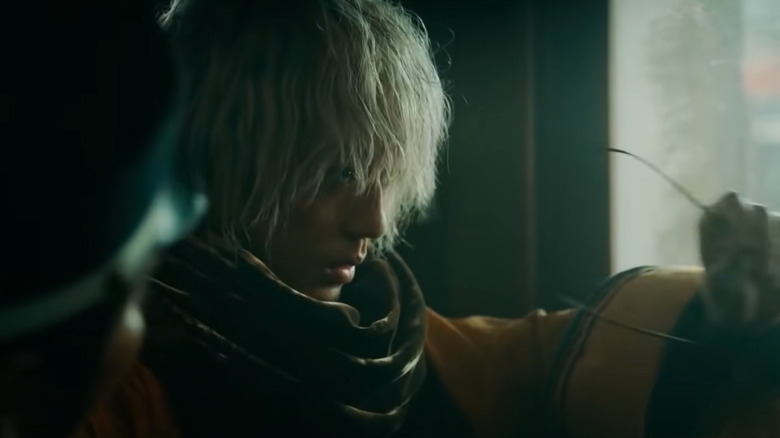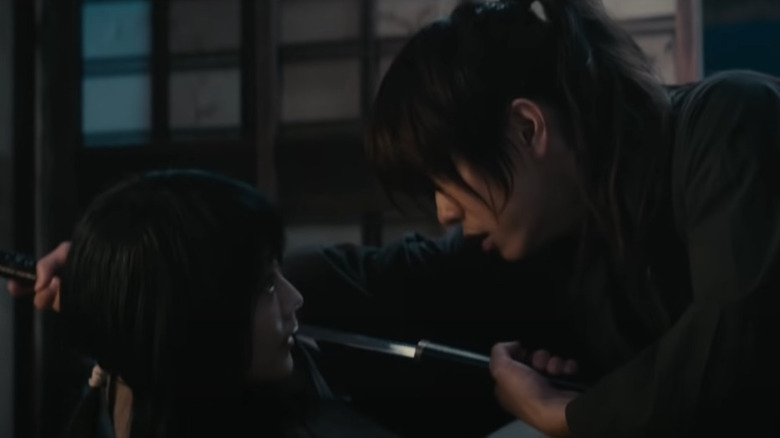Every Rurouni Kenshin Movie Ranked Worst To Best
What does it take for a cold-blooded assassin, the very best in his line of work, to turn his back on killing and become a pacifist? Can true peace be obtained by force, and can violence truly be curbed with more violence? Perhaps most importantly, how can a retired swordsman hope to survive against a seemingly never-ending stream of vengeful villains out for his blood, when all he has is a sword with a reverse edge?
Since its 1994 debut in the pages of Japan's Weekly Shōnen Jump magazine, "Rurouni Kenshin: Meiji Swordsman Romantic Story" has grown from a promising manga to a pop culture phenomenon. Also known as "Samurai X" in other countries, "Rurouni Kenshin" follows the adventures of Kenshin Himura, a former revolutionary assassin with a cross-shaped scar on his cheek who, for initially mysterious reasons, turned his back on killing and re-emerged as a wanderer with a reverse-edge sword (or sakabatou). With an estimated 72 million copies in circulation, "Rurouni Kenshin" was one of the top-selling manga titles of its time, becoming so successful that it actually helped keep its then-struggling home magazine alive. Its popularity spawned an animated series, multiple OVAs (Original Video Animations, separate from the main show), and even a quintet of commercially successful live-action films released internationally over the course of nine years.
Here are our rankings for the five live-action Rurouni Kenshin films, listed from worst to best. Oh, and there will be spoilers.
5. Rurouni Kenshin: The Legend Ends
The third film in the series, "Rurouni Kenshin: The Legend Ends" sits at the bottom of the franchise's Rotten Tomatoes ranking ladder, despite its respectable audience rating. While this definitely says a lot about the quality of the "Rurouni Kenshin" films as a whole, it also highlights the elements that made "The Legend Ends" far less legendary than its predecessors.
Leaning heavily into the fantastic techniques and elements of Kenshin Himura's world turned out to be a double-edged sword for "The Legend Ends." Despite his description of the sword fights as "handsome choreography," The Guardian's Mike McCahill called the film "a demonstration of the modern movie business's absurd gigantism: seven hours of set-trashing for a story that needed two tops." Indeed, what was supposed to be an epic conclusion to the film version of a popular story arc ended up being a bloated, thinly spread story with only the barest of substance, as Clarence Tsui of The Hollywood Reporter pointed out. Arguably, it was a two-parter that could have been just one.
Roxy Simons of Eastern Kicks praised actor Tatsuya Fujiwara, whose Makoto Shishio served as the main foil to Takeru Satô's Kenshin, for "portraying a nuanced version of his character and vulnerabilities that made his end all the more satisfying." Ultimately, however, "The Legend Ends" is, for many critics, the lowest point of the series. Or, as Trevor Johnston of Time Out described it, a "disappointing" entry with "a less-than-exciting grand finale."
4. Rurouni Kenshin: Kyoto Inferno
The two-and-a-half-hour "Rurouni Kenshin: Kyoto Inferno" comes next on the Rotten Tomatoes ranking board for the series. Marcus Goh of Yahoo! Style ponders if the runtime could have been shorter, even though the overall narrative was "properly structured and satisfying."
For starters, "Kyoto Inferno" brought quite a few fan-favorite characters to life. Aside from the thoroughly singed Shishio's menacingly bandaged visage, audiences also got to see the Jūppongatana (Ten Swords) group, including fleet-footed Seta Sojiro (Ryunosuke Kamiki), a ruthless young killer who could almost give Kenshin a run for his money. Unfortunately, as Goh noted, introducing so many characters meant giving each of them less screen time (and thus, less room to be fully fleshed out).
In a review for SnapThirty, Jahanzeb Khan praised the soundtrack and fighting choreography of "Kyoto Inferno," calling them improvements over the previous film's music and sword clashes. Khan also found Shishio and the Jūppongatana to be a stronger threat not just to Kenshin, but all of Japan. Meanwhile, ScreenAnarchy's Christopher O'Keeffe said that perhaps a less faithful adaptation that focused more on making the film work in its intense, realistic setting could have resulted in a better production overall. Perhaps The Guardian's Mike McCahill summed it up best, while pointing out how the filmmakers leaned more towards "flagrant expansionism" than the action that audiences were expecting: "This samurai sequel is, like so many western blockbusters, an 80-minute B-picture stifled under an extra hour's worth of expensive production design."
3. Rurouni Kenshin
Released in Japan in 2012 and in the United States a year later, "Rurouni Kenshin" was the world's first taste of the planned film series' level of quality. Fortunately, it met and even exceeded many fans' expectations. In particular, the filmmakers made the right call in casting Satô, who was no stranger to portraying superhero-like protagonists, as the titular character. "Rurouni Kenshin" was received quite well by audiences, as evidenced by its high rank on the Rotten Tomatoes audience scoreboard.
Deborah Young of The Hollywood Reporter took note of the "fast and furious" sword choreography that truly sold Satô's skills as the former manslayer Hitokiri Battosai. Maggie Lee of Variety praised action director Kenji Tanigaki's choreography, likening the way Kenshin makes short work of multiple enemies on his own to the "balletic, kinetic style" of Hong Kong action flicks. However, Lee also felt that the 134-minute film had a "pedestrian" story and an unconvincing romance, boiling it down to "barnstorming swordplay, pretty faces and a no-brainer plot" that nevertheless got the job done.
Had "Rurouni Kenshin" been a failure, it would have endangered the chances of its sequels getting made. Fortunately, the filmmakers were able to balance action, comedy, drama, and mystery in a film set against the backdrop of Japan's early Meiji era. Despite its caricature-like villains and plot inconsistencies, "Rurouni Kenshin" was hailed by Geek.com writer and longtime Rurouni Kenshin fan Michelle Nguyen as "the best live action adaptation of an anime [she had] ever seen."
2. Rurouni Kenshin: The Final
When "The Legend Ends" came out in 2014, many assumed that it would be the end of the film series. However, a 2017 news report revealed that at least one new sequel was in the works. Fans would later find out that not one, but two films would mark the end of the series — and that both would be on the streaming platform Netflix.
The first of the two, "Rurouni Kenshin: The Final," sits at the top of the Rotten Tomatoes ranking list for the franchise, and with good reason. Bringing together the original cast for one last adventure, "The Final" introduces audiences to Enishi Yukishiro (Mackenyu Arata), a frightening foe from Kenshin's past. Unlike previous antagonists in the franchise involved in illegal drugs or bent on ruling Japan, this white-haired villain wants nothing more than Kenshin's head on a platter, imbuing the plot with a true sense of peril for the scarred swordsman. Alex Rallo of Polygon praised Mackenyu's "tangible charisma," and also appreciated the diverse set of rogues under Enishi's command.
Aside from well-choreographed fights and a carefully handled romantic subplot, "The Final" also gave viewers a glimpse of many characters' fates, including one reformed villain who turns up as an unexpected ally near the film's climax. In a review for Decider, Johnny Loftus called this adaptation of the manga's longest arc a "satisfying" production that "fully engages with its big battle energy." Indeed, "The Final" tells a compelling, action-packed story, source accuracy notwithstanding.
1. Rurouni Kenshin: The Beginning
It may seem odd to end a film series at the start of its story, but that's exactly what the franchise did with "Rurouni Kenshin: The Beginning." Incidentally, out of all the Rurouni Kenshin films, "The Beginning" is the one that works best as a standalone film: You don't need to have seen any of the other movies to understand it. In fact, seeing it will only enhance your appreciation of all the films that came before it. "The Beginning" also does away with the over-the-top elements of previous installments, focusing on showing the audience how Kenshin Himura became the legendary assassin-turned-pacifist of this fictional late 1800s Japan in the first place.
Writing for Anime News Network, Richard Eisenbeis took note of how this film was far more brutal and bloodier than its predecessors, in spite of its more grounded portrayal of Kenshin's signature Hiten Mitsurugi-ryū style. As he put it, "Instead of beautifully choreographed sword fights, the film's battles look like nothing more than people frantically trying to kill each other." Meanwhile, Dylan Griffen of The Young Folks compared its violent final fight to legendary filmmaker Akira Kurosawa's 1950 thriller "Rashōmon": "Two vulnerable men desperately cling to life while attempting to slay one another, without grace or dexterity, but clamoring for survival."
"The Beginning" is powerful enough to serve as an introduction to Rurouni Kenshin or a fascinating, post-"The Final" character study of the protagonist — and it's the best film in the entire franchise.
